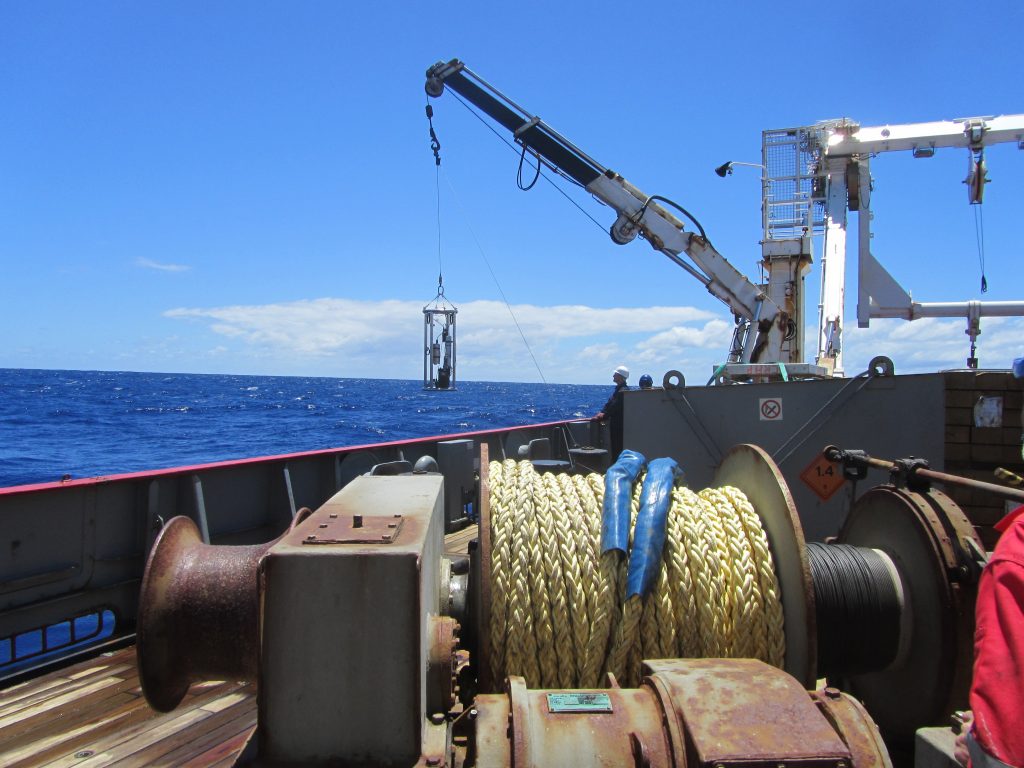On this vast deep blue slab of ocean, we have not seen any wildlife for days and it would appear on the surface that there is nothing out here except occasional white horses looming ferociously around the ship. Similarly, the satellite ocean colour imagery that we receive daily from the Copernicus programme indicates that there is little phytoplankton in the surface layer of the ocean.

Out on a vast, deep, blue, slab of ocean. (PML)
The Conductivity-Temperature-Density (CTD) trace and material from Madeleine’s zoo-plankton net hauls, however, paint a different picture.
Below us, between 80 and 130 metres, there is broad peak in the fluorescence profile indicating higher phytoplankton at depth that peaks at 110 metres. The sample that Madeleine takes from her zooplankton nets is teaming with tiny marine animals.
The zooplankton are food for fish, such as anchovies, which Giorgio and Bob have been detecting in the backscatter signal. They continually graze the phytoplankton crop, but are rather ‘sloppy feeders’ and as they feast on the phytoplankton cells, they release proteins, amino acids and nutrients back into the water, that Carolyn is measuring.
These released nutrients, in turn, become food for marine bacteria and small phytoplankton. This process is known as the microbial loop whereby large zooplankton feed on small zooplankton which in turn feed on small phytoplankton. These open ocean regions are so deep (>4.5 km) that nutrient-rich deep waters seldom reach the surface. The sunlit, upper ocean is fuelled by re-mineralised nutrients from grazing and breakdown of phytoplankton cells by zooplankton, bacteria and marine viruses. The system is a delicate balance between phytoplankton growth, zooplankton grazing and the release and re-mineralisation of nutrients.
Any adverse effects on this tightly coupled chain can have major consequences higher up the food chain on the fish and whales that graze either the phyto- or zooplankton.
The sunlight is so intense at these latitudes that if the small pico and nano-phytoplankton, such as syneccococus and prochloroccocus, are carried to the surface, they can explode due to the intensity of the visible and ultraviolet light. They therefore reside at the deeper layers of the ocean, surviving on low light and re-mineralised nutrients.
Giorgio characterises the light field daily at solar noon. Glen measures the abundance of these small phytoplankton groups using flow cytometry. Kerry is measuring the carbonate chemistry and the respiration and oxygen consumption of the communities.
As the mixed layer deepens, these organisms and other organic matter gets sheared upwards into high light and can be photochemically transformed into different components, which are either transformed into other nutrient pools or released as gases. These vast blue deserts occupy 70% of the world’s oceans, and these tiny phytoplankton play an important role in maintaining the delicate food web that sustains life in these huge ocean ‘deserts’.
Post from Gavin Tilstone, Plymouth Marine Laboratory
For more information: https://amt4sentinelfrm.org
Twitter follow: @AMT4SentinelFRM








Discussion: no comments